What Are Mason Bees?

You’ve almost certainly heard of honeybees, but what about mason bees? These docile fliers are extremely helpful in your garden, and there’s an easy way to invite them into your backyard: a bee house. Here’s everything you need to know about mason bees.
Discover fascinating bumblebee facts you should know.
Mason Bees vs Honeybees
There are more than 150 species in the mason bee group, which handled pollination here long before European honeybees arrived. Unlike honeybees that gather pollen in packages on their hind legs, mason bees collect pollen in a rather amusing fashion: They belly-flop into blossoms, and the pollen clings to the hairs on their bodies. According to Thyra McKelvie of Rent Mason Bees in Bothell, Washington, they can pollinate up to 2,000 flowers per day, and each one can do the work of 100 honeybees. Impressive!
Because they’re well-adapted to the climate here, they fly in cooler temperatures and brave drizzly conditions.
Meet more beneficial bees you want in your garden.
Do Mason Bees Sting?

The busy fliers are valuable in home gardens because they pollinate an array of early-blooming plants. Plus, they’re easy to raise and fun to watch. Renowned for their gentle disposition, they are suitable for families with children and are not aggressive even in close proximity. Male mason bees do not sting. And about the only way to incite a defensive sting from a female is to squeeze or step on her.
The reason for their non-aggression? They don’t have hives, so there is nothing for them to defend. Instead of using honeycomb cells, they lay their eggs in existing gaps or tunnels. A female creates a mud plug on one end, adds a loaf of pollen and nectar, then lays an egg. The next layer follows the same pattern until the tunnel is packed with eggs and sealed with more mud. Hence the name “mason” bee.
“Their life cycle is similar to a butterfly,” Thyra says. While a honeybee queen lays 1,500 to 2,000 eggs per day, a female mason bee produces only 15 in her four-to-six-week lifetime.
Discover 6 key differences between bees and wasps.
Mason Bee Cocoon
Once the eggs hatch, each larva consumes its pollen loaf and spins a silken, hardened cocoon to overwinter in. Young mason bees emerge when conditions warm in spring. The males (noted by the white tuft of fuzz on their heads) appear first, with females appearing soon after.
Discover 8 bugs you should never kill in your garden.
How Do I Attract Mason Bees to My Yard?
Creating an ideal environment for these bees is critical. According to Matthew Shepherd, director of outreach and education for the Xerces Society for Invertebrate Conservation, planting native flowers is a must—and of course, avoid using pesticides in your garden. To help mason bees nest, he says you can provide nesting sites. To do this, allow a certain level of imperfection in your yard and garden. For example, they may use chambers in dead trees where birds have pecked holes to find insects.
Psst—we found the best flowers that attract bees.
Mason Bee House

For a more direct way to add them to your backyard, you temporarily host them by ordering a bee house from Rent Mason Bees. It’s simple! You order a kit (which includes bees) to arrive in early spring. When the bees are done pollinating your yard, mail back the nesting block. Rent Mason Bees harvests, cleans and protects the cocoons over the winter and then provides bees to farmers and gardeners, who release them into their crops. Here’s why we love beeswax wrap as a natural alternative to plastic wrap.
Next, learn 6 easy ways how you can help bees.
Tips for Growing a Clementine Tree
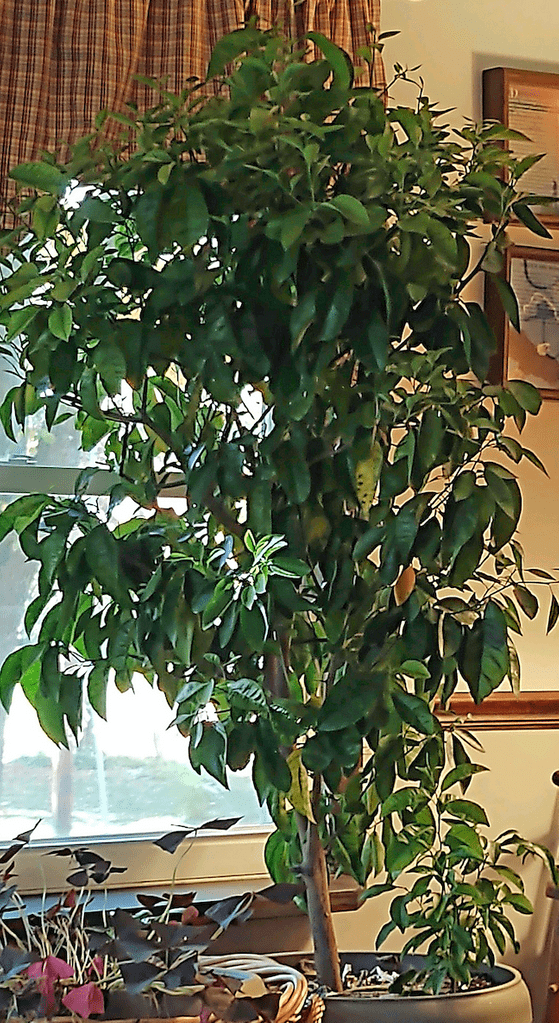
“I have a 15-year-old indoor clementine tree (above) that I planted from seeds. How much bigger will it get?” asks Dianna Elder of Howard, Ohio.
You obviously have mastered the proper care for this citrus plant. Clementines sold at nurseries are usually grafted onto a dwarfing rootstock so they grow only about 6 feet tall. Grown on their own, like yours, they have the potential to reach 25 feet in height.
Check out expert tips to grow an indoor avocado tree.
Since your tree is growing in less than ideal conditions for citrus, it will take quite a few years to reach that height. Prune your clementine tree in spring to help control the growth as needed. Avoid extreme pruning as that can stimulate excessive growth, requiring even more pruning the following season.
If you live in zone 8 or colder regions, you will need to bring your tree indoors before the first frost. Keep your tree near a sunny window until the weather warms up again.
Learn how and when to fertilize citrus trees.
Where to Buy an Indoor Clementine Tree

We found clementine trees available online at retailers like Etsy, Garden Goods Direct, Fast Growing Trees and Nature Hills Nursery. Keep in mind that these trees are young trees (not full sized) and they will continue to grow.
You can also purchase an EasyPeel Clementine tree from Fast Growing Trees. These are the sweet, easy-to-peel tiny clementines that kids love. You’ll often see these small citrus fruits sold in mesh bags at the grocery store.
The trees will produce a bountiful crop of delicious, nearly seedless fruit (clementines are usually ready to pick in November or December). And the spring blossoms will fill your home with a lovely fragrance. Another perk—these trees are resistant to diseases and insect pests, so you will not need to apply pesticides.
Note that these trees cannot be shipped to some states due to agricultural regulations.
Next, check out the top 10 dwarf fruit trees for small spaces, and learn everything you need to know about growing fruit trees indoors.
White Peacock Butterfly Markings

If you see a white butterfly fluttering by, take a closer look at the white wings. If it’s a white peacock, it’ll have brown markings and subtle orange hues along the wings’ edges. From above, look for one dark spot on the forewings and two on the hindwings. Their wingspan measures 2 to 2 3/4 inches.
A white peacock’s appearance may seem more pale during winter. Learn how to tell the difference between a moth vs a butterfly.
Where to Find a White Peacock Butterfly

These spotted white butterflies can be seen in the Southeast. White peacocks do travel as far west as Texas and north as North Carolina, and may occasionally even be seen in northern states during warmer months. You may see these butterflies along rivers, ponds and swampy areas and in fields.
Check out 11 kinds of butterflies you should know.
What Do White Peacock Butterflies Eat?

Just like with other butterflies, planting a pollinator garden with nectar flowers is a good way to draw in white peacocks. You’ll want to grow bidens and frogfruit in particular to attract these butterflies.
“I spotted a white peacock (above) in the heat of summer at a local nature center in southwest Michigan. I love photographing butterflies from different perspectives, especially from beneath when I can see their faces. Each one is so uniquely beautiful and intricate,” says Marguerite Eichelberger of Berrien Springs, Michigan.
Meet garden royalty: The viceroy butterfly.
What Does a White Peacock Caterpillar Look Like?

These caterpillars are dark with tiny white flecks throughout the body, in addition to intimidating spines to scare off potential predators. Take a caterpillar quiz to see how many caterpillars you can identify.
Look for a mourning cloak butterfly in early spring.
Host Plants and Eggs
Look for tiny, pale green eggs underneath leaves on water hyssop, frogfruit and wild petunia plants. Check out the top 10 butterfly host plants to attract pollinators.
A lot of planning, time and money go into attracting and feeding backyard birds. But making your space appealing to them with food and plants they love is only one part of the equation. You also need to ensure that birds stay safe while in your yard. With these tips, you are on your way to a bustling backyard full of feathered guests. Creating and maintaining a bird-safe yard requires a bit more work and dedication beyond simply putting up a feeder. But the peace of mind that comes with doing your part to keep birds safe is extremely rewarding.
Learn how to create the ultimate backyard wildlife and bird habitat.
1. Clean Feeders Regularly

Dirty feeders can spread disease. Completely empty yours about once every two weeks, and more often in wet weather or if the food looks moldy. Take each feeder apart, then clean it thoroughly with dish soap and boiling water or a dilute bleach solution (one part bleach to nine parts water). Rinse the feeder well, dry it completely and refill with fresh seeds or other bird food. Clean hummingbird feeders and change the sugar water every three to five days.
Learn how to clean a bird bath.
2. Monitor for Bird Feeder Disease
If you see birds that look ill—watch for crusty eyes, growths on their bodies or unusual behavior — take your feeders down immediately. Clean them thoroughly and wait several weeks before you put them back up. Keep an eye out for news stories about bird epidemics in your area and follow all recommendations to protect your feathery friends.
3. Say No to Pesticides
Birding and gardening go hand-in-hand, and understanding how birds, bugs and plants benefit one another greatly enhances the rewards. As an active gardener, you probably have found bugs eating your plants and felt the urge to take action. But it’s important to know that most pesticides are nondiscriminate killers that don’t just eliminate specific bugs. Pesticides kill important pollinators, like honeybees and butterflies, as well as helpful insects like lady beetles.
Although many kinds of lawn fertilizers with weed killers are harmful to wildlife, you still should consider organic fertilizers. Building your soil with a strong combination of compost and organic fertilizers is critical. If you forgo all fertilizers, you can end up with poor plant growth, fewer bugs for birds to eat, and soil erosion as plants decline. Psst—here’s the best natural way to kill weeds.
And reducing the overall use of harsh pesticides in yards is healthier for humans, too. A pesticide-free healthy lawn is the safest option for your favorite birds, other wildlife guests, pets and even you, too!
Check out 7 natural ways to keep bees and wasps away from hummingbird feeders.
4. Use Bird Safe Glass for Windows

Windows pose a huge risk by reflecting the sky or trees nearby, which invites birds to fly right into them. Researchers estimate that window collisions kill up to 1 billion birds a year, especially during migration season. New data indicates there is no truly safe distance from a window to put bird feeders, so be sure to make any windows facing your feeders easy for birds to see. Deck these windows with specially designed anti-collision stickers, decals, bird tape or films that create an opaque surface outside. Or mark the window using soap in a grid pattern of 4 inches by 2 inches. Here’s more tips to prevent bird strikes on windows at home.
5. Keep Cats Indoors

Cats are lovely and make wonderful companions. But if you love birds and enjoy feeding them, it’s best to keep your cats indoors. Studies prove the devastating impact that roaming house cats and feral cats have on birds and small mammals.
House cats are not native and also are not part of the natural ecosystem. Many people believe that a well-fed kitty wouldn’t have any reason to hunt birds, but even cared-for cats have the instinct to go after birds. Feeders and roaming cats are a lethal combination. If you have an outdoor cat, or if many strays visit your yard, it may be best if you refrain from feeding the birds, for the birds’ own safety. Or, you can create an outdoor enclosure or cat patio for your feline friend. This allows your kitty to be outdoors without being a threat to birds. Remember that, according to veterinarians, indoor cats live longer, healthier lives. So keeping your pets inside not only protects the birds, it’s also better for the cats.
6. Stop Hawks at Bird Feeders
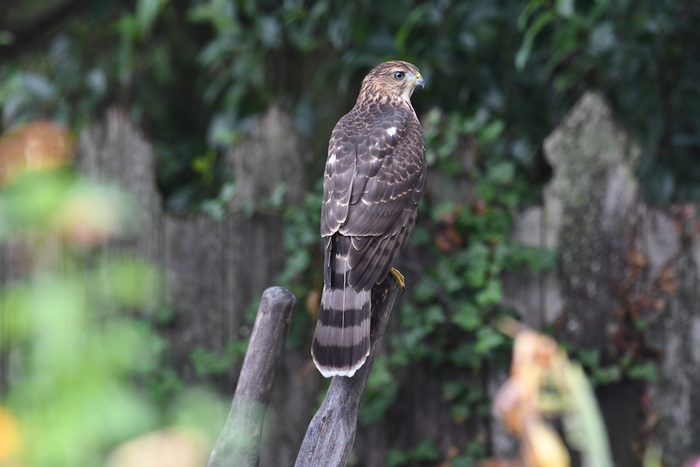
Feeders provide a quick lunch, but they also can turn diners into an easy meal for others. Add plenty of shelter nearby where backyard birds can escape when hawks circle above. Shrubs and trees are perfect choices. Foil ground predators such as foxes by hanging feeders high and using a squirrel baffle beneath. A cage-style feeder gives smaller birds an extra layer of protection while they feast. What foods do hawks eat?
7. Avoid Red Dye in Hummingbird Sugar Water
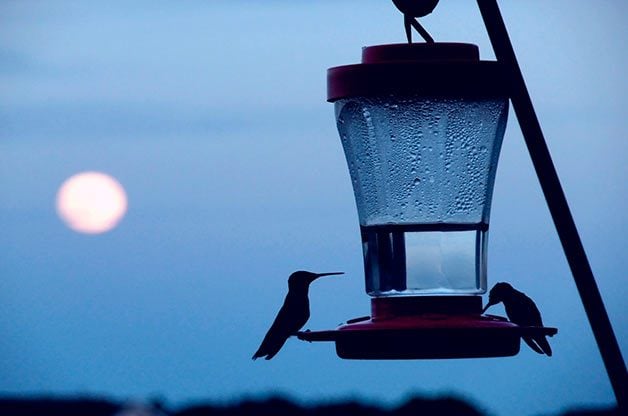
Beware: Some retailers offer hummingbird food colored with red dye. Most leading experts agree that the dye can be harmful to birds, and at the very least it’s unnecessary. The top recommendation for hummingbird food is to make it at home. Here’s the sugar water recipe. Any other kind of sweetener besides white granulated table sugar may be unsafe.
Check out 9 foods you should never feed to birds.
8. Grow Beneficial Plants and Trees

Birds rely on berries, seeds, nectar and the insects that plants attract for food. Grow native plants, shrubs and trees in your yard to attract a wider variety of birds in every season. Birds also use native trees for nesting, and evergreens provide winter shelter. Visit your local plant nursery to ask for recommendations.
Editor’s note: This story was excerpted from Planting for Wildlife with permission from author Jane Moore and Quadrille Publishing.

If your goal is to build the perfect backyard bird habitat, there’s a good chance you’re already planting, growing and gardening with birds in mind. But a backyard wildlife sanctuary can benefit many other species, too, with a little time and effort.
So, what’s the best way to both maximize your yard for local wildlife and create habitat for your feathered friends? How do you get more bang for your buck? In this list, we offer a variety of tips to help you turn your backyard into a haven for birds, butterflies, bees and other cherished wildlife.
Psst—here’s how to create an ideal hummingbird habitat.
Assess the Bird Habitat in Your Local Area

Chances are that your garden is part of a street or neighborhood with other gardens close by. These gardens all provide essential cover for wildlife large and small, allowing them to move through the area, feeding, breeding and creating homes and habitats for themselves and their offspring. Instead of regarding your garden as an individual space, think of it as part of a green corridor for local wildlife.
Look at what is around you in the parks and gardens nearby—are there trees, shrubs and ponds, perhaps? Look at which plants are lacking but also which plants are attracting the birds and wildlife.
To attract birds, offer food, water and shelter.
Look for Year-Round Fruit and Flowers

Planting for year-round interest is great for our gardens but even better for wildlife. Many native plant species are ideal for attracting creatures, but they don’t necessarily have a long season of interest, as they have adapted to make the most of specific seasons. Choosing plants with long flowering times outside of spring and summer means that your garden is a potential food source for early season hatchlings and migrating birds and pollinators. By planting a long season of flowering and seeding plants, you’ll keep bumblebees, butterflies and birds very happy.
Plant a Tree
A well-chosen tree or shrub will provide food and shelter for many species, from tiny insects to larger birds and mammals. Even the tiniest garden or backyard can usually accommodate a small tree or large shrub —after all, the great thing about a tree is that it goes upward, not necessarily outward. Trees can also be the focus for wildlife-friendly additions to the garden such as hanging feeders, nesting boxes and birdhouses. Many trees and shrubs are specially bred to grow well in pots and containers. The crucial thing is to choose wisely. You don’t want an oak tree in a garden the size of a handkerchief!
Here’s 5 essential steps for tree planting success.
Build a Log Pile

It’s such a simple thing to do—and is invaluable in wildlife terms. Many invertebrates such as insects and beetles love to make their homes in piles of decomposing wood. And, while these might not be the wildlife you were hoping to attract to your garden, they will draw in larger birds and mammals, which will feed on them.
A rotting pile of wood might not be your idea of heaven, but it is to many insects, as well as fungi and invisible microorganisms, which all help to create a beneficial environment for wildlife to thrive. There is also something fascinating about watching the logs crumble and decay surprisingly swiftly, as nature takes its course and the wildlife has its way.
Check out the bugs you should never kill in your garden.
Create a Pond

Making the space for some water isn’t always easy, plus there are safety concerns if you have young children and pets, but it really is the single most important thing you can do to attract wildlife into your garden and create a bird habitat. You don’t need a huge lake—in fact, it can be really quite small—but water is simply vital to life.
Take a Break from Weeding
It can be hard to let things go, but learn to relax about weeds to build a better wildlife and bird habitat. Weeds are some of the best wildlife-friendly plants there are. Nettles, daisies and buttercups, among others, are important sources of food for many insects, including butterflies and moths. One of the reasons for this is that they are so persistent, flowering readily and for a long time, whatever the weather, providing much-needed food when other plants aren’t.
Leave a Gap in Your Fence

That little gap is a superhighway for creatures great and small to travel from your garden into the wider world. This allows frogs and toads—which are valuable in your yard!—to move from pond to pond, and beetles to go from garden to garden. That little gap links together a network of different habitats, helping to create green corridors in towns and cities.
Grow Climbing Vines

Clothing your walls and fences with vining plants provides a wealth of habitats for many creatures, even in the smallest of gardens. Bees, butterflies and insects of all kinds will enjoy the flowers as well as the welcome cover, while birds will enjoy eating fruit, perhaps even nesting in the denser foliage. Evergreens such as ivy provide year-round cover, as well as flowers and fruit, but clematis, roses, honeysuckle and many other climbers also provide a better refuge and home for wildlife than a plain fence.
Try the top 10 vines for hummingbirds.
Let the Grass Grow

Long grass is a brilliant habitat for many plants and insects. These may not be the most exotic species—although you never know what may start to colonize after a few years—but long grass is a veritable jungle, providing food and shelter for many insects, from moth and butterfly caterpillars to crickets and beetles. Leave the grass to get taller, and the clovers and daisies will grow and flower, hugely boosting the amount of available nectar with no effort whatsoever on your part. If only all gardening was so easy.
Speaking of crickets, did you know they aren’t the only insects singing in your garden at night? Learn all about katydids.
Make Some Compost
All that effort you’ve saved in mowing can be channeled into making a compost heap. This is a win-win: Making and using your own compost in your borders and vegetable garden will naturally enrich your soil so you won’t need chemical fertilizers. Not only that, but the compost heap itself is a habitat in its own right, providing sanctuary and nourishment for worms, woodlice and many other creatures, including frogs.
More Ways to Build a Backyard Bird Habitat

Reduce Pesticide Use
When you have caterpillars, bugs, butterflies and young birds exploring your backyard in summer, the last thing you want is for them to be harmed by pesticides. Make an effort to reduce pesticide use for the health of wildlife.
Check out 10 natural ways to eliminate garden insect pests.
Put Out a Buffet for Birds

In addition to offering plants for wildlife, it’s also good to put out different kinds of food. Of course, the birds and wildlife in your area will do just fine without it, but if you want an up-close view of the fliers in your bird habitat, this is the way to get it. Start by putting out black-oil sunflower seed and a sugar-water feeder. Then add items such as suet, thistle seed, safflower seed and peanuts.
Check Your Birdhouses
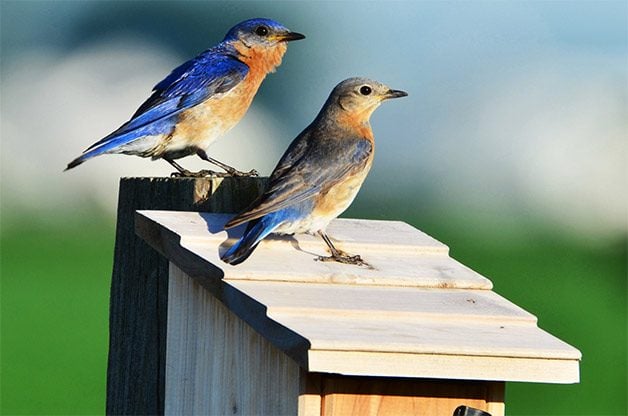
Many commercial birdhouses are more decorative than useful, so be sure to do your homework. For instance, if you want to attract bluebirds, make sure your backyard bird habitat is suitable, and then choose a bluebird house with the right dimensions and hang it in the right area. Do a little research to learn about dimensions for different species before you buy.
Offer Birds a Source of Fresh Water

Along with food and shelter, water is one of the three necessities of every wildlife habitat (and especially a bird habitat). A larger water feature is remarkable, but at the least, consider adding a bird bath. Birds will flock to it, especially in the heat of summer. Here’s how to attract birds to use a bird bath.
Get Rid of Invasive Plants and Grow More Native Plants
Visit the USDA’s website for a list of Introduced, Invasive, and Noxious Plants. You can search by state to see some of the invasive plants in your area. Once you know what they are, work to get them out as soon as possible. While you’re ridding your yard of invasive plants, replace them with native plants, which almost always suit the needs of local wildlife. Planting natives suited to your growing conditions will feed and shelter birds, butterflies and other creatures, and native plants are instrumental to good bird habitats.
Check out the top 10 easy-to-grow native plants.
Don’t Forget About Butterflies

Nectar-rich plants bring in butterflies, so you have lots of options there. But don’t forget host plants for their eggs and caterpillars, such as milkweed for monarchs. Look for butterfly gardening resources in your area.

True to the scientific method, the Great Backyard Bird Count started out of curiosity. Researchers at the National Audubon Society and the Cornell Lab of Ornithology had an observation and a question.
The observation: Scientists could better understand, monitor and protect global bird populations with access to real-time information. The question: Would backyard birding enthusiasts be interested in counting birds and reporting their results online?
The community responded with a resounding yes, and the Great Backyard Bird Count (GBBC) subsequently launched in 1998. It was the first online citizen-science project to collect data on wild birds and display results almost instantaneously. Participants record sightings of both rare and common birds such as northern cardinals or mourning doves. This successful worldwide initiative connects people through birding.
“It even fueled the creation of eBird, which is one of the world’s largest citizen-science projects related to birds,” says Becca Rodomsky-Bish, project leader for the Great Backyard Bird Count. “And eBird is a very powerful conservation tool.”
Follow these birdwatching tips for beginners: Here’s how to start birding.
Great Backyard Bird Count Basics

The premise is simple. Birders across the globe come together to watch, count, study and celebrate birds. It’s held every February, for four days during Presidents’ Day weekend in the United States. See the Great Backyard Bird Count’s website to find out this year’s dates.
To participate, birders are asked to watch and count birds at least once during the event. While watching, they record any information they see or hear. Then they submit their findings using the Merlin Bird ID app, eBird Mobile app, or eBird website. That’s it!
“It’s a good fit for entry-level and less experienced bird-watchers because of the fact that you only have to bird for 15 minutes, and you can do it anywhere you choose,” says Kathy Dale, Audubon’s community science team leader.
Psst—before you get started, make sure you have binoculars and a bird field guide.
Research Has a Global Impact

This real-time research, provides undergraduate students, professional researchers and the general public access to decades of reporting.
“There are a lot of questions people can ask and find answers to when using this data,” Becca says. “Questions like ‘What birds are we seeing? Are birds that are normally found farther south being found farther north? Is that linked to climate change? What are we seeing in terms of feeding behaviors? Where are birds migrating, or not migrating, to?’’
Discover 15 common backyard birds you should know.
Get Your Friends and Family Involved
Some people choose to bird solo. But the Great Backyard Bird Count provides several opportunities for families, schools and home-schoolers, Scout groups and Audubon Nature Center visitors to band together for the good of birds everywhere.
“I love citizen science and being able to do something in my own backyard that contributes to something bigger,” says participant Megan Long, a naturalist at Oxbow Park & Zollman Zoo in Minnesota.
Megan has enjoyed watching birds with co-workers, her parents and even her youngest relatives in the four years she’s participated in the GBBC. Once, her 5-year-old nephew proudly taught her patience when he started his birding session by kicking off his shoes, putting his feet on the windowsill and exclaiming, “Well, sometimes you just have to wait!” Here’s how to get kids excited about birding.
“What you observe might be something small and simple on your end, but when you have so many people contributing, it creates a bigger picture of not only what’s happening in your state, but globally,” Megan says.
“The global nature of GBBC is really important because birds don’t pay attention to geopolitical boundaries,” Kathy says. “Being able to see people across the globe excited about what they are seeing in their area is really fascinating.”
Psst—check out the bird-watching gear you didn’t know you needed.
Increasing Interest During the Pandemic
As COVID-19 forced people indoors, birders flocked to the GBBC. “The momentum really built,” says Kerrie Wilcox, Canadian coordinator for the Great Backyard Bird Count on behalf of Birds Canada, which joined the event in 2009. From 14,300 global checklists completed in 1998 to more than 330,000 in 2020, the program supported people through the isolation and lockdowns of COVID-19.
“Birding is so good for people’s mental health,” Kerrie says. “It gives you a connection to nature that has proved helpful over the past year.”
In 2021, reports came from more than 190 countries, and checklists from Canada surged 109%.
Go birding in the city: Find out how to be an urban birder.
Fun Great Backyard Bird Count Facts

- One of the largest flocks observed in 2021 was a mix of more than 3,000 Ross’s geese and snow geese spotted south of Sacramento.
- In 2021, participants at Florida’s Dry Tortugas National Park witnessed 1,000 sooty terns, a seabird that wanders tropical oceans and nests on remote islands.
- Accidentally introduced to Florida in the 1980s, the eurasian collared dove has expanded its range to more than 39 states and into Canada, GBBC data shows.
- GBBC data supports evidence of the Anna’s hummingbird expanding its wintering range from desert scrub and the suburban yards of Pacific states into British Columbia.
- Quebec birders spotted more than 700 common redpolls in one flock in 2021, due to poor seed and cone production in boreal forests farther north.
Next, learn about the Christmas bird count, and World Migratory Bird Day, too.
Why Grow a Mountain Ash Tree?
You get the best of both worlds when it comes to mountain ash. It’s a beautiful tree and its berries attract tons of wildlife, from birds to pollinators. This native tree changes with the seasons, offering something new and exciting every few months.
Check out the top 10 trees and shrubs with berries for birds.
How to Grow Mountain Ash Trees
- Mountain Ash
- Sorbus spp.
- Perennial in Zones 2 to 7
- Full sun or part shade
Planting a mountain ash tree in an appropriate site is key to the health of the tree. Choose a spot with acidic, sandy and moist soil. Follow these steps to plant a new tree.
Mountain ash is susceptible to some diseases, such as scab (a fungal disease) or fireblight. Prune out infected branches to slow and manage the spread of disease. Be sure to clean and disinfect your tools between pruning.
Psst—we found 15 trees you should never grow in your yard.
Why Wildlife Love Mountain Ash Trees

These trees are a wildlife magnet. The fruit attracts cedar waxwings, robins, gray catbirds, thrashers, eastern bluebirds and at least a dozen other berry-loving bird species.
When the berries are not available, the trees appeal to other wildlife, too. Pollinators like bees and butterflies are drawn into its flowers. Watch for them on the white blooms in spring.
Also, keep an eye out for caterpillars. Mountain ash is a host plant for eastern tiger swallowtails. You might be able to see adults laying eggs, caterpillars nibbling the leaves, or even a cocoon.
Discover the top 10 butterfly host plants to attract pollinators.
Backyard Benefits and Berries
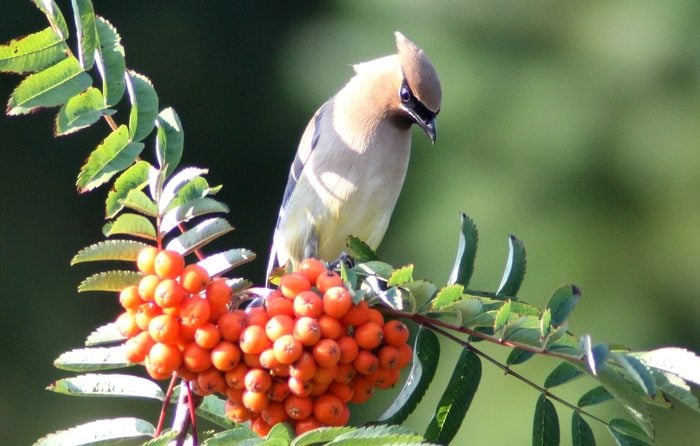
It’s the perfect size for a small backyard, only reaching 10 to 25 feet tall. The tree is just tall enough to use as a small shade tree or showcase as a specimen plant.
Plus, it wows in nearly every season. The dark green summer leaves change to yellow, orange and red hues in autumn. They offer winter interest, too. The bright orange-red berries look gorgeous on snowy branches and keep the birds coming back for more. And in spring, delicate white flowers offer nectar and pollen to fluttering pollinators. This tough little tree is also tolerant of strong winds.
Are you ready to plant a native bird garden? Here’s how to do it.

Stroll through any bird store and you’ll find prepackaged suet squares readily available in many varieties, from pure suet to those that include seeds, nuts and berries. While those are fine options, it’s fun and inexpensive to make your own. Learn the do’s and don’ts of rendering suet for birds.
On This Page
Rendering Beef Suet for Birds
Real suet, in its traditional form, is raw beef fat. Raw suet needs to be rendered. Available at most butcher shops, the good stuff is super popular among nuthatches, chickadees and all woodpeckers, especially during the cold months. In fact, suet is one of the best foods for woodpeckers.
First, chop it into small pieces. (If you purchase it from a butcher, he or she may do this for you.) Next, heat the chopped fat on low until it’s completely melted. To remove potential contaminants, strain the liquid fat twice through a layer of cheesecloth. This also ensures that your suet cakes stick together and don’t crumble.
Psst—Check out the best suet feeders for winter birds.
How to Make DIY Suet Cakes

You can serve rendered suet plain or put a little love into it and experiment with various bird-safe ingredients. Mix in unsalted nuts and seeds, fruits and berries, peanut butter and cornmeal until the consistency is a bit stiff. Some people even mix in dried mealworms and other insects to entice bluebirds! Once the mixture has cooled a bit, press into molds (try cat food or tuna cans, or form into your favorite shape) and refrigerate.
Making your own suet involves a bit of trial and error. Depending on the ingredients you choose to mix in, you may need to experiment with the ratio of ingredients to avoid crumbly cakes.
“What’s your favorite suet recipe?” asks Birds & Blooms reader Diane Mlekush of McHenry, Illinois.
We actually haven’t settled on a favorite recipe, because we’re always experimenting with new ideas. But when we make suet, we always begin with equal parts lard and peanut butter, melting and mixing them over low heat. We add a variety of ingredients to this gooey mess: peanuts, raisins, rolled oats and cornmeal, to name just a few. Then we chill the mixture for a day before cutting it into blocks or cubes. When you offer birds homemade suet, check it regularly to be sure it isn’t moldy or rancid.
Switch up your bird feeding habits to see new species.
Safe Ingredients for Suet
- Black-oil sunflower seeds
- Unsalted nuts
- Dried fruit
- Peanut butter
- Cornmeal or flour
- Other birdseed
- Rolled oats
Check out 8 common questions about suet for birds.
Unsafe Ingredients for Suet
While rendering suet to attract birds is incredibly rewarding, there are a few things to know before you jump in headfirst. Always avoid bacon grease, bread and table scraps. Ingredients such as corn and peanuts sometimes foster dangerous bacteria. If you use these, it’s important to keep the mixture refrigerated until you’re ready to use it in your feeders.
- Bread
- Sugar
- Leftovers
- Meat
- Bacon fat
- Salted nuts
Discover 9 foods you should never feed to birds.
Make Suet Cakes With Lard, Not Bacon Grease
Lard is a safe alternative to rendered beef fat. In fact, a combination of lard and peanut butter makes a nice base for any bird-friendly recipe. But bacon drippings are not recommended because the chemical preservatives in commercial bacon become more concentrated when cooked. This doesn’t pose a health threat to humans but can be harmful to birds.
Next, see our list of the foods you should feed birds in winter.
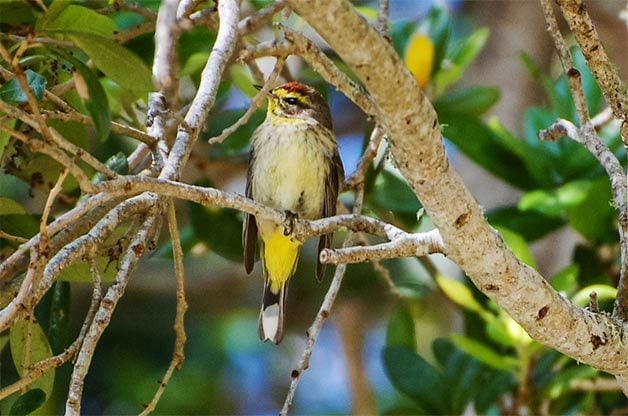
Question: I spotted this bird (above) in my backyard near a warbler, but I couldn’t identify its species. What kind of bird is it? —Sandra Castle of Vero Beach, Florida
Kenn and Kimberly: This bird is also a warbler. It’s a palm warbler, a type that spends the summer in the boreal spruce forests and bogs in eastern Canada and the northeastern U.S., migrating south to spend the winter in the southeastern states and around the Caribbean. Look for them on islands and along the coasts. In Florida, it’s the second-most common warbler seen in winter, after the yellow-rumped warbler.
What Does a Palm Warbler Look Like?
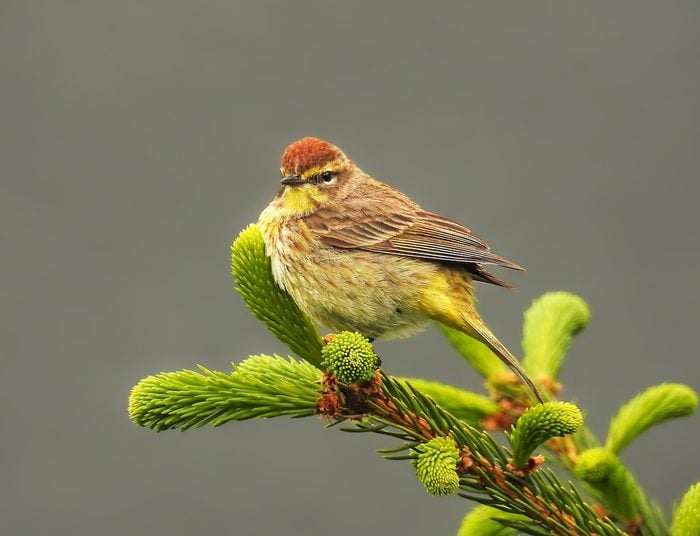
The keys to recognizing this species are the yellow under the tail and the reddish brown cap and a yellow eyebrow stripe. Palm warblers often spend time on the ground, hopping about and bobbing their tails up and down like a palm tree swaying in the wind. Male and female palm warblers both look similar.
Check out 25 small yellow birds you should know.
Palm Warbler in Winter

Question: “Can you identify this bird (above)?” asks James Firmin of Friendswood, Texas.
Kenn and Kimberly: Seen here in its confusing winter plumage, this is a palm warbler. The thin bill and white spots on the tail are typical of warblers. In winter, key field marks for this species include the strong face pattern, with dark eyeline and noticeable pale eyebrow, overall brown look, and the touch of yellow under the base of the tail.
Despite their name, palm warblers spend their summers mainly in the spruce bogs of Canada. They visit coastal Texas from midautumn to early spring. Although most members of the warbler family are forest birds, palm warblers often venture out in the open and are frequently seen foraging on the ground in the colder months.
Yellow warbler vs goldfinch: Here’s how to tell the difference.
What Do Palm Warblers Eat?
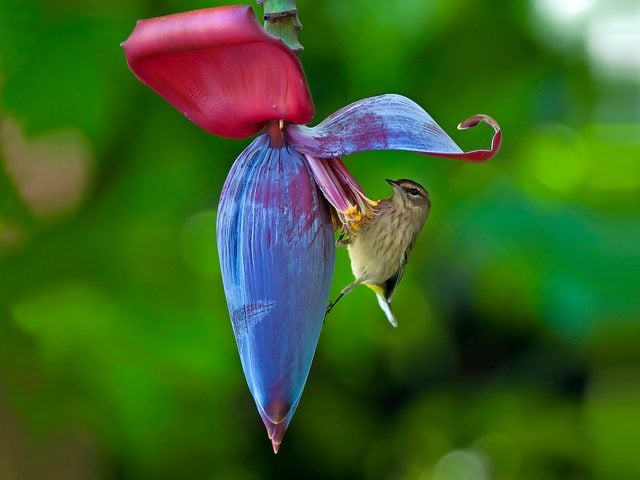
Insects make up most of their diet, and they feed in short-to-medium vegetation rather than high in the treetops. But they also go for natural nectar sources, as this bird (above) is demonstrating.